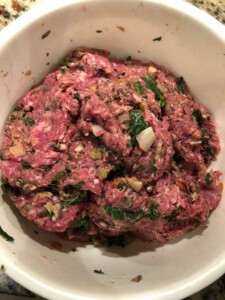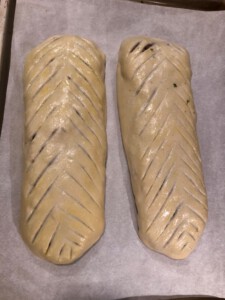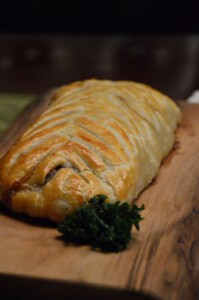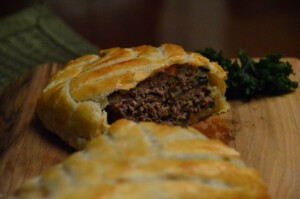Mince or Ground Meat Wellington
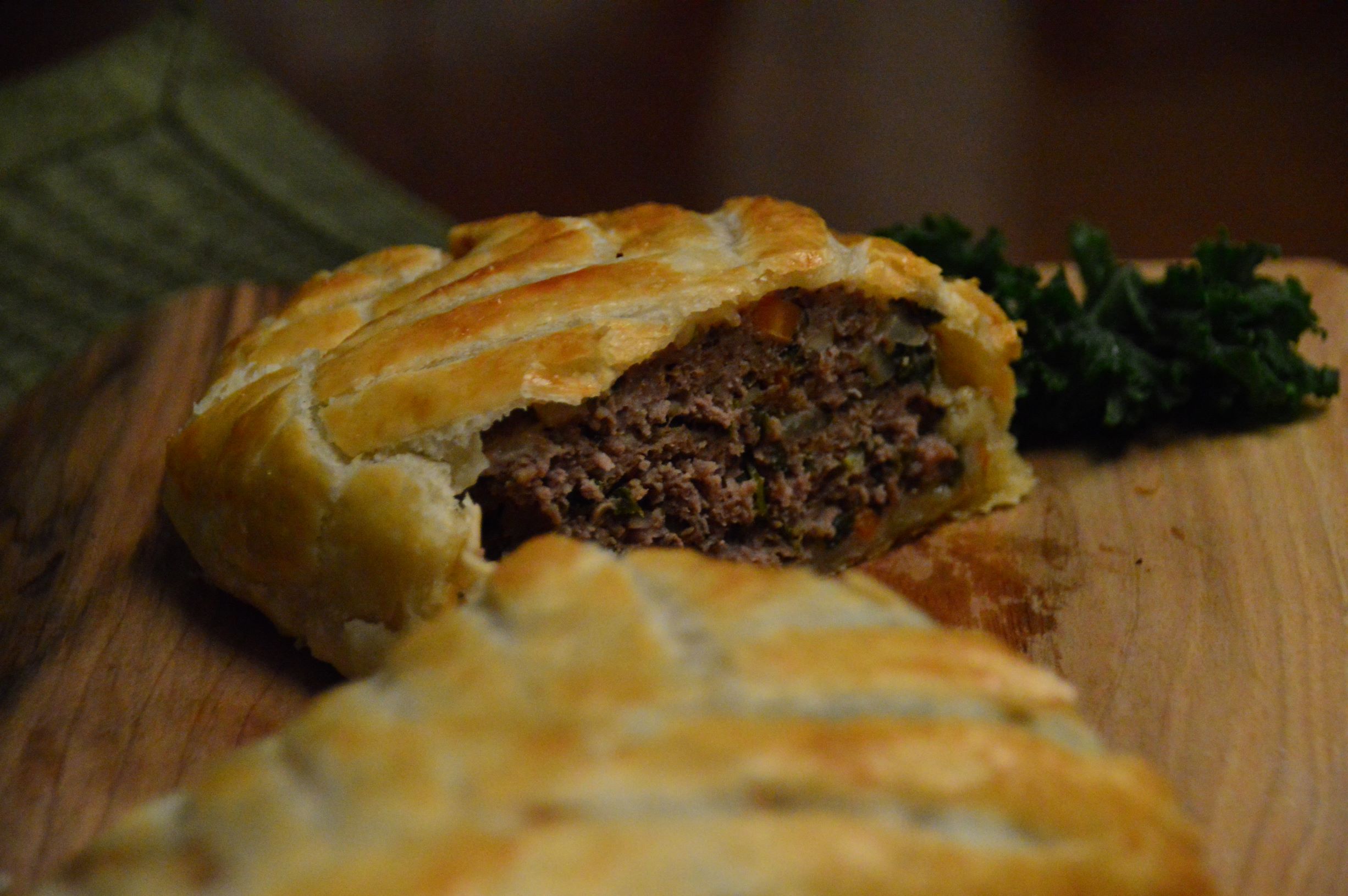
My kid’s have excellent taste. They asked me to cook a Beef Wellington. Right…. I guess the a la carte must be excellent at Bistro SmellaQue? How am I going to execute this dinner request?
Foodies often miss the level of difficulty in cooking a Wellington, a meatloaf is hard enough. One would hate to have a soggy puff pastry along the bottom. What if the beef tenderloin is overcooked? Or worse! What if the puff pasty is so wet, that it unravels and falls off the beef? I can picture the sloppy disappointing mess now. Yikes! I have to avoid a poor foodie review!
In an effort to save $60-70 for beef tenderloin, I remembered my neighbor graciously shared his hunting find. Ground moose meat! Yes, my neighbors are awesome! Obviously experienced, the moose had already been premixed with pork fat. Moose, like game meats tends to be very lean. Hunters often mix game meat with pork fat to improve the moisture content of game meat.
Goals:
- Ensure the contents of the puff pastry do not crumble or fall out
- Retain moisture in the meat mixture
- Cook the puff pastry
- Enjoy a flavorful dish
- Keep the moisture entrained in the meat mixture without the puff pastry becoming soggy
Food Learnings – Keeping mince or ground meat juicy:
- Speed of cooking mince can influence how quickly moisture is expelled out of the meat. Raw meat is mainly a complex binding of protein and water (amongst nutrients, fat and other stuff). Mince or ground meat has cut the long strands of bound protein into smaller bits. Often the meat is then commingled with other fat. When heat is applied hot and fast, protein strands react quickly. They twist and squeeze any water that it is bound to the molecule. Think of when you cook ground beef on high heat, there will be a pool of liquid on the bottom of the pan. Thus, cooking mince or ground meat at lower temperatures over a longer time will help the meat hold onto its moisture.
Recommendation: Cook mince meat at low to medium temperatures to gently cook the meat. The downfall to this approach is that “browning” of ground meat will be little to none. The meat will turn a grey-brown, but not show a seared caramelized brown color. <Searing ground meat sounds better on TV than in real life.> - Finishing temperature – When cooking a steak or a roast to maintain its original juices, one will observe that meats cook well (finished at higher temperatures like 150F) will be less juicy than on the rarer side (at lower finishing temperatures like 125F).
Recommendation: I don’t have a cost effective or efficient way to assessing the finishing temperature of ground meat, so I usually look for most of the meat (~80%) to turn grey-brown signifying its cooked with bits of pink and I’ll turn the stove off. I’ll let the residual of the hot pan cook the remaining meat. - Fat keeps meat juicy, creates mouthfeel and adds to the perception of moisture in meat. So ground beef for burgers is best when there is fat added or entrained in the ground; the burgers are juicy.
Recommendation: Ensure ground meat has fat content. The amount of fat should be appropriate to the meat mixture dish you are cooking.
- Adding starch and liquids is called mixing a “panade.” Starches can be bread, flour, breadcrumbs, crackers. Panade liquids like milk, broth or water are commonly used. Panades are excellent to mix with ground meat as the saturated starch will coat proteins and interferes with the proteins to reduce the moisture that is squeezed out of the moisture. Therefore, the protein holds onto the moisture and your meat mixture is not dry and crumbly.
Recommendation: Mix panade with ground meat for meatballs, koftas, burgers, meatloaf and now, mince or ground meat Wellington. - Add gelatin. In meats like brisket and pork shoulder, hard working muscles have a high quantity of collagen. Over long periods of heat and time (like smoking or BBQing) the collagen will convert to gelatin. Yes, gelatin like Jello? Yes, granny’s wobbly fruit flavored dessert. Gelatin is what creates the smooth texture on your tongue, creates body to a sauce, mouthfeel when eating a burger. Fun fact, gelatin is the only protein that thickens liquids. Heat causes gelatin to unravel and stick, creating at a web that absorbs moisture. Gelatin absorbs 10 times its own weight! When temperatures cool off, the gelatin lines up and maintains the sticky attribute but now in an organized mass. Cook’s Illustrated’s Science of Good Cooking book suggested to add gelatin to meatloaf. If it works for meatloaf, surely it will work for a meatloaf wrapped in puff pastry!
Recommendation: Adding gelatin to a mass block of meat with heat can absorb moisture and entrain it in the “meat block.” I proved it, gelatin works well for Mince or Ground Meat Wellington.
Taste: Thyme and parsley accentuates the meat, little to no game flavor, considering my version used moose
Texture: Puff pastry was crisp and flakey on the top and nice finish on the bottom (not soggy, yay!!). Meat mixture held together, but was not dry or solid-like. It held together well, especially when slicing into portions, while also holding moisture.
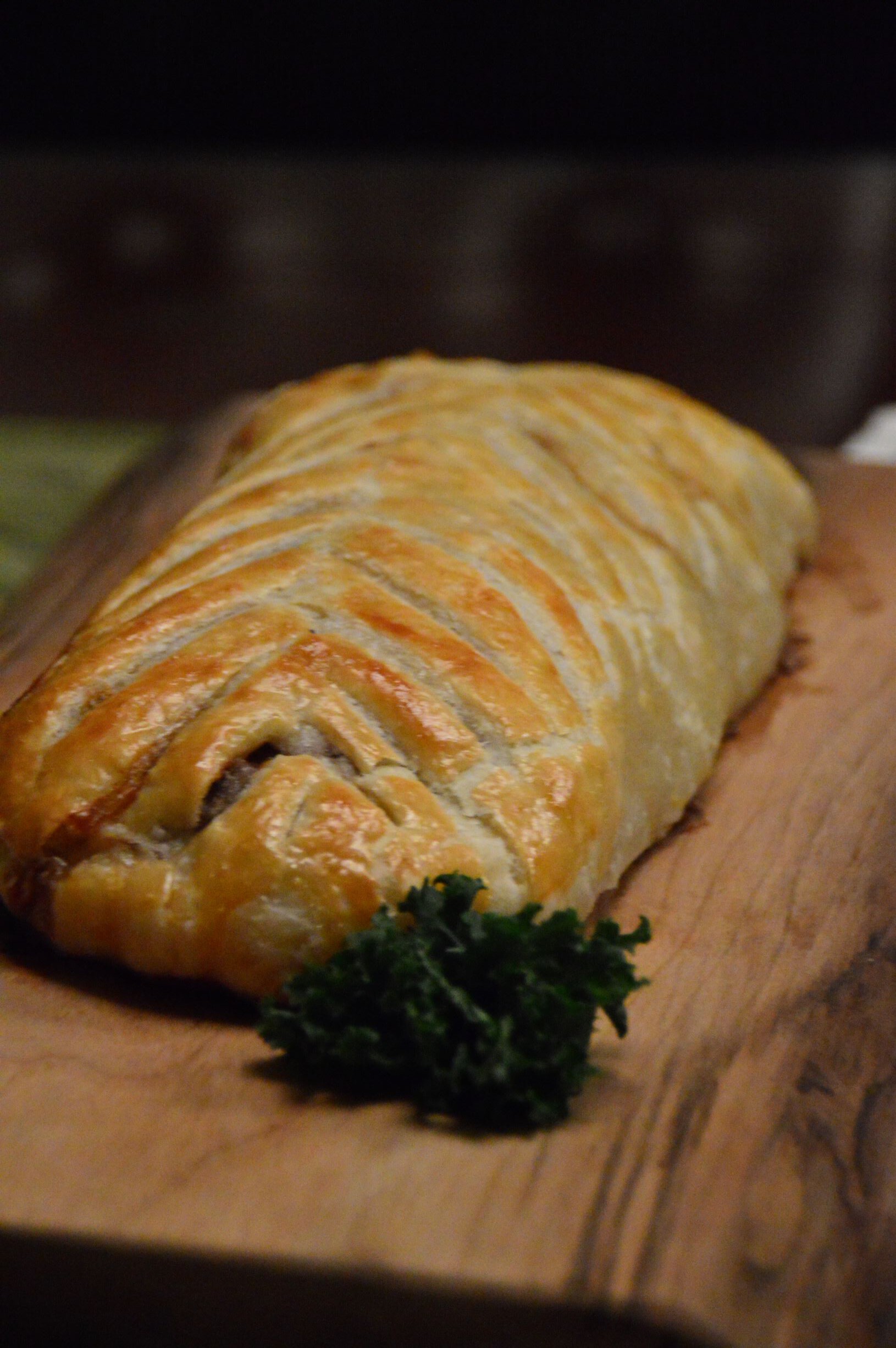
Mince or Ground Meat Wellington
Ingredients
Equipment
Method
- Preheat oven to 300F
- In a frying pan on medium heat, drizzle vegetable oil.
- Add onion to the pan and cook for 1 minute or until onions start to sweat.
- Add garlic, carrot, celery, mushrooms and cook for 10 minutes until vegetables soften.
- Add kale to pan and cook for 1-2 minutes until kale is a vibrant green and vegetables have softened. Turn off the heat to the stove. To the warm vegetables, add dried oregano, dried thyme, dried parsley and cayenne pepper.
- In a large mixing bowl, transfer vegetable herb mixture to cool.
- Across the top of the vegetable herb mixture, sprinkle dried breadcrumbs, table salt, black pepper and gelatin. Add Dijon mustard to the mixture.
- Add ground/ mince meat to the large bowl.
- Add 2 eggs to the large bowl.
- Use your hands or a rubber spatula to mix the ground/ mince meat with vegetables and eggs into a cohesive mixture.

- In a small bowl, crack an egg open and leave egg as is in the bowl.
- On a lightly floured surface, attach two pieces of puff pastry together by brushing egg white onto a 1” strip of one edge and overlapping the second piece of puff pastry by 1 inch. Roll the puff pastry into a 10 x 14” rectangle.
- Brush egg white across the surface of the puff pastry. This will be a glue and prevent the bottom of the puff pastry from getting soggy.
- Transfer the contents of the meat vegetable mixture onto the puff pastry in a log shape, leaving 1 1/2” from both ends of the length of the mince/ground meat log.
- Seal the meat log lengthwise by bringing the edges of the puff pastry on the shorter width to wrap and tightly overlap and seal across the length of the mince/ground meat log.
- Seal the ends of the meat log by pushing the overlapped seam down on the ends of the log and pull up the bottom layer of the puff pastry to seal the ends of the log. Pinch and seal any openings in the puff pastry.
- Lay a piece of parchment onto a baking sheet.
- Quickly flip and transfer the puff pastry meat log onto the parchment laid baking sheet.
- In the small bowl with the egg, quickly scramble the egg. Brush the egg mixture across the top and sides of the puff pastry meat log.
- Use a sharp knife to slice parallel slice marks into the top of the puff pastry.

- Sprinkle kosher salt on top of the puff pastry.
- Place the puff pastry meat log on the pan into the oven. Allow to cook for 50 minutes until the internal temperature is 140F. Puff pastry will be lightly brown.
- Increase the oven temperature to 400F to broil and keenly watch the puff pastry turn a golden brown. It can be very quick, within 3 minutes! Remove from oven when the color of puff pastry is as desired.

- Allow the Mince/ Ground Meat Wellington to rest on the parchment baking sheet for at least 20 minutes at room temperature undisturbed.
- Using a sharp knife to slice into 1 ½ inch slice from the end for the first cut (this has the extra puff pastry on the end) and slice into ¾ to 1 inch widths for further slices.


